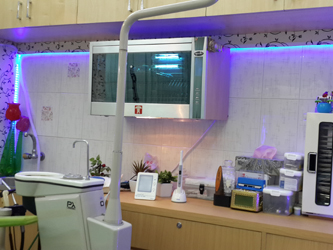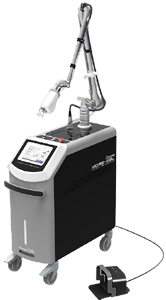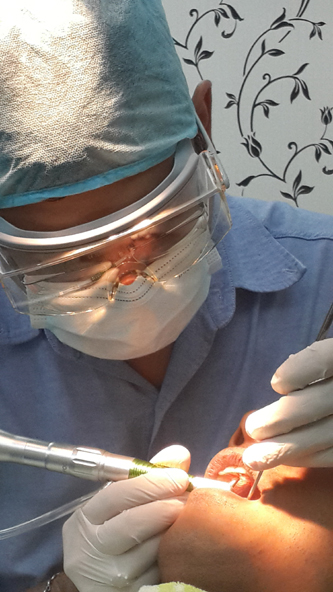Laser Dentistry
The Rifats Laser Dental Care has access to the best types of latest Generation lasers for each of the procedures performed. These procedures are offered on the basis that in each instance, the use of a laser is directly beneficial to the patient. Some other non-laser operations performed in Dentistry are also offered, since technological advances in these areas also give a benefit to patients over old-fashioned surgeries.
We have done more than 30000 successful laser and dental cases the number of procedures are expanding as technology advances. We offered multi directions of the clinic's surgery also in Cosmetic and facial plastics.
We use ideal lasers for most applications in Cosmetic surgery and in many cases the correct laser in the correct clinical situation offers significant advantages to the patient over standard non-laser methods.
The Rifats Dental Implant Laser Cosmetic Care has been proposed and developed by Dr. G K M Rifatullah and Dr. Nabanita, all of whom have particular skills in their own fields. Surgeons affiliated to the clinic are either trained internationally or be particular experts in their own field of laser surgery. The aim is to provide a high quality service to remaining independent from all other laser users in Rifats Laser Dental Care.

The Rifat's Dental Implant Laser Cosmetic Care will concentrate on day case surgery in this area, with the emphasis being on a high quality service minimizing disruption to the patient's lifestyle. This includes a streamlined approach to consultation, treatment and postoperative care.
Why Lasers?
Lasers in medicine use the physical fact that a light beam carries energy. If this energy is of the correct wavelength and intensity, change can be caused to living tissue, the degree of change being proportional to the amount of absorption of light by each individual tissue component. This absorption of light depends on the optical properties of each separate component of tissue, and the wavelength of light being transmitted to the tissue. Different tissues therefore absorb light of different wavelengths maximally. The aim is to select the wavelength of light that is best suited to treat the tissue that requires treatment.
Laser energy can also be very delicately delivered due to accurately focused lenses or small diameter fibres (down to 200 microns). Laser light can also be short pulsed (less than 1 millisecond) by computer control of the beam, reducing unwanted damage. Due to these facts alone or in combination, diseased tissue can be removed whilst reducing normal tissue damage, in some cases diseased tissue can be treated with almost no normal tissue damage.
Lasers also have the ability to stop bleeding simultaneously with a cutting action, allowing rapid, bloodless operations, reducing anaesthetic time. This leads to a quick recovery, and often little pain in the early postoperative period. This is a very useful advantage when performing surgery as a day case, which all of the Clinic's operations are designed to be.
Types of Lasers & Use :
 Carbon Dioxide (CO2): This system involves the production of laser light from a gas medium that is mostly CO2 as found in the atmosphere. Light can be delivered in a very delicate manner, either by fine pulsing or scanning. Because there is minimal absorption of light at this wavelength (10,600 nanometres), very accurate removal of tissue is possible. The CO2 laser is the workhorse of most Cosmetic laser surgery. At RDLC we use this laser for cosmetic skin surgery and several other procedures.
Carbon Dioxide (CO2): This system involves the production of laser light from a gas medium that is mostly CO2 as found in the atmosphere. Light can be delivered in a very delicate manner, either by fine pulsing or scanning. Because there is minimal absorption of light at this wavelength (10,600 nanometres), very accurate removal of tissue is possible. The CO2 laser is the workhorse of most Cosmetic laser surgery. At RDLC we use this laser for cosmetic skin surgery and several other procedures.- Holmium-Yttrium Aluminium Garnet (Ho-YAG): As its name suggests, this laser produces light from a crystal (garnet), containing the rare earth metal Holmium. Light at this wavelength (2,300 nanometres) produces a beam that vapourises tissue and also stops bleeding (coagulation), a property that is very useful in areas that have a good blood supply. The Holmium-YAG laser is ideal for lingual tonsil treatment, throat and mouth/tongue cancer surgery, and for tonsillectomy when a tissue sample is needed.
- 980 Diode: A relatively new concept in lasers, this system uses a physical property of tissue in which specially prepared chips containing Gallium Aluminium Arsenide are stimulated by electricity to produce laser light. These systems are small, lightweight and easy to use. They therefore lend themselves to being carried from clinic to clinic. Diode lasers offer delicacy in contact mode, or good coagulation in non-contact mode. We use this system primarily at 652 nanometres for photodynamic therapy.
Benefits
1. Pain Reduction
Patients will experience considerably less postoperative pain in almost every instance. This reduction in pain is a result of the unique characteristics of the laser beam as it cuts nerve endings, preventing the raw ends typical to scalpel incisions. The CO2 laser seals nerve endings as it "cuts", so your patient will likely require less anesthesia during the operation, and enjoy easier recuperation.
2. Swelling Reduction
Whenever an incision is made in the tissue with either a scalpel blade or scissors, inflammation begins in the affected tissue. This inflammation is a result of interaction with the circulatory and lymphatic systems. Because the laser beam effectively cauterizes the lymphatic system, there is much less postoperative swelling. In addition, laser energy does not crush, tear, or bruise tissue since there is no physical contact with the tissue. Postoperative Recovery is faster and the patient experiences more comfort.
3. Control of Infection
Since laser beam operates at a temperature of over 200 degrees Fahrenheit; it is highly effective at killing bacteria that have the potential to cause an infection. In fact, this is particularly important in areas in which it is difficult to prevent contamination of the surgical site. The CO2 laser sterilizes the infected area as it removes diseased tissue, leaving healthy tissue undamaged. Because the sterilization process is so effective, the use of antibiotics is substantially reduced.
 4. Minimal Surgical Bleeding
4. Minimal Surgical Bleeding
When an incision is made with a scalpel blade, blood vessels in the area are severed, and can ooze during and after the surgery. Traditionally this is controlled by clamping the torn vessels with hemostats, cauterizing the vessel using electro-surgery, or holding gauze sponges until the bleeding stops. All of these procedures take time, which means the surgery takes longer and there is more postoperative swelling. The laser seals small blood vessels as it cuts, reducing or completely eliminating the need for any other bleeding control measures. This means less time is required for the surgical procedure and, usually, reduced need for anesthesia.
5. Hospitalization and Healing Time
With laser surgery, healing is rapid and there is less postoperative discomfort. Laser procedures provide reduced trauma and less invasive surgeries for patients, improve recovery time, and shorten time spent in the hospital. No tissue reaction (edema) is usually noted. The laser allows destruction of diseased tissue while preserving normal tissue. Post surgical scarring is also reduced.
6. Greater Accuracy & Precision
The laser can remove diseased tissue without affecting surrounding healthy tissue. Not only does the blood-free cutting benefit the patient, it also provides a clear, dry surgical field for the surgeon. The lack of bleeding improves the surgeon's visual control of the procedure because he can clearly see the different tissue layers. As a result, the surgeon is able to enhance surgical precision.
Would you like a professional opinion? BOOK AN APPOINTMENT
Values | Innovation | Professionalism
Our Commitment to you

We are committed to provide oral and dental services in the most friendly, diligent and transparent manner within a framework of ethics, safety and quality. Patient satisfaction is our top priority.
Your smile | Our passion | Professionalism beyond expectations
Our Mission and Goal
To provide a ‘better than excellent’ service to our patients; patient satisfaction is our ‘number one commitment’.The Rifats Dental Implant Laser Cosmetic Care has been proposed and developed by Dr. G K M Rifatullah and Dr. Nabanita, all of whom have particular skills in their own fields. Surgeons affiliated to the clinic are either trained internationally or be particular experts in their own field of laser surgery. The aim is to provide extreme quality services to remaining independent from all other dental practitioners. We use lasers in Oral, Dental as well as cosmetic surgeries and in many cases the correct lasers in the correct clinical situations offer significant advantages to the patients over standard non-laser methods. These are at these specific areas that the Rifat's Laser Dental Care and Surecell Laser Dental Aesthetics are aimed.
The Rifats Laser Care has access to the best types of latest Generation lasers for each of the procedures performed. These procedures are offered on the basis that in each instance, the use of a laser is directly beneficial to the patient. Some other non-laser operations performed in Dentistry are also offered, since technological advances in these areas also give a benefit to patients over old-fashioned surgeries.We have done more than 30000 successful laser and dental cases and the number of procedures are expanding as technology advances. We offered multi directions of the clinic's surgery also in Cosmetic and facial plastics.

